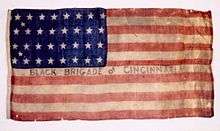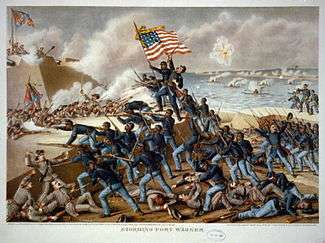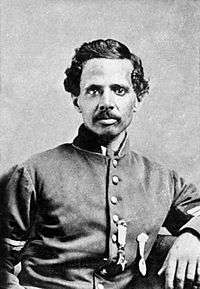Black Brigade of Cincinnati
The Black Brigade of Cincinnati was a military unit of African-American soldiers, that was organized in 1862 during the American Civil War, when the city of Cincinnati, Ohio, was in danger of being attacked, by the Confederate Army. The members of the Cincinnati "Black Brigade" were among the first African Americans to be employed in the military defense of the Union. The fortifications—including forts, miles of military roads, miles of rifle pits, magazines, and hundreds of acres of cleared forests—at the border of Northern Kentucky thwarted the major threat to Cincinnati during the Civil War.[1][2] Richard Cooper of the Freedom Center states, "If the African Americans had not stood up at this time period, Cincinnati probably would have fallen to the Confederacy."[3]
| Black Brigade of Cincinnati | |
|---|---|
 The Black Brigade of Cincinnati American Civil War Memorial honors the free African Americans who constructed the defensive fortifications, around Cincinnati, Ohio, during the American Civil War, in preparation of a potential Confederate attack. The Brigade would later shoulder their shovels in a military manner and march in the victory parade through the city. | |
| Active | September 2, 1862 - September 20, 1862 |
| Allegiance | United States of America |
| Branch | Cincinnati volunteer militia Union Army |
| Size | Battalion-brigade (700) |
| Nickname(s) | Black Brigade |
| Engagements | No combat experience |
| Commanders | |
| Notable commanders | |
Brigade service
Background
Race relations in Cincinnati at the time were incredibly volatile.[2] While the city had more than its share of exceptional abolition leaders [4] before the American Civil War, the attitude of Cincinnatians in general towards abolitionism was one of open hostility. Most of the citizens discountenanced the institution of slavery but were willing to wink at its continuance in the South for financial reasons. [5] The intensity of sentiments has risen up to destruction of property, killings, and mob violence against blacks since about the 1830's. Peter H. Clark states, "Nowhere has the prejudice against colored people been more cruelly manifested than here."[6] Cincinnati, which lies along the Ohio River in southern Ohio, bordered the Union-held slave state of Kentucky. People from Ohio were "aggressively barring" blacks from migrating to the state.[7] State laws, called the Black Laws of 1804 and 1807, required that blacks provided proof that they were free and posted $500 guaranteeing good behavior.[7] Blacks did not have the right to vote. They could not testify against white people in trials, whether by law before 1849 or mob rule after the law preventing their testimony was overturned.[7]
Volunteer force proposed

In August of 1862, with the imminent threat of a Confederate attack, black Cincinnatians met to organize a home guard and offer their services in defense of the Union cause in defense of their city.[8] Hearing that they were meeting to discuss providing service during the war, there were attempts to shut down the meeting and intimidate attendees. The Commercial stated that black men should not interfere in the war.[9] Their offer was refused by the city, and they were told there no need for their help in a "white man's war." This was contrary to the wishes of Maj. Gen. Lew Wallace who intended to enlist the help of the city's black residents to construct defensive fortifications.[8]
Advancing Confederate troops
On August 30, Confederate troops defeated Union Army troops during the Battle of Richmond at Richmond, Kentucky (about 100 miles south of Cincinnati). By early September 1862, Union Army companies from Ohio, Indiana, and perhaps other northern states, came to the Cincinnati area to defend it from the advancing Confederate Army.[10] Wallace put the city under martial law on September 1st and assumed command of the city. Mayor George Hatch asked for all men to assist in the defense of the city and that the police force would be placed under Wallace's command and act as provost guards.[9]
Men unexpectedly forced into service
On September 2, 1862, the Cincinnati police force abruptly and forcefully impressed male black residents to construct fortifications, often at gunpoint and with rough treatment, and without a plan or explanation.[8] The men were gathered and put in a mule pen on Plum Street, not knowing what would become of them and fearfully that they might be left in Kentucky and become enslaved.[11]
If the guard appointed to the duty of collecting the colored people had gone to their houses and notified them to report for duty on the fortifications, the order would have been cheerfully obeyed. But the brutal ruffians who composed the regular and special police took every opportunity to inflict abuse and insult upon the them whom they arrested.
— Peter Clark, Black Brigade of Cincinnati[9]
Some of the men labored at the river and others were taken at bayonet to work as servants, camp cooks and laundrymen for Union troops at Fort Wright.[8][2] About 400 men were taken to regimental camps and were held there.[8] They were held for two days,[12] during which they worked continuously for 36 hours without sleep and received half rations of food.[11] The treatment was denounced by the Cincinnati Daily Gazette, that stated "Let our colored fellow-soldiers be treated civilly" and "treated like men". It was the only local newspaper to condemn the unjust treatment.[8][12]
Fortifications
Alarmed by reports of the mishandling by the police force and mistreatment by the army, Wallace put Colonel William M. Dickson in charge, who let the seized men return to their homes and announced a new call for black volunteers to report the next day.[8] In the meantime, the police were relieved of provost guard duty[12] and promised not to arrest any more black men, except for criminal activity.[11] Black men who had escaped to the country or were securely hidden to avoid coming under control of the provost guards, returned to the city.[12]

At 5 a.m. on September 5th, 706 volunteers reported for duty and were put to work.[8][2] The officers of the brigade as of September 6, 1862 were all white and included: commander, William M. Dickson; Adjutant-General, T. C. Day; Commissary, H. McBurney; Quartermaster, J. S. Hill; Assistant Adjutant-General, Jacob Reior.[10] With Dickson in charge, the soldiers of the Black Brigade received their own military unit flag and $13 a month--a Union Army private's pay--along with various privileges, including the right to visit their families.[14]

Put "far in advance of the Union lines" and without weapons,[12] a pontoon bridge was built to bring the Black Brigade into Northern Kentucky.[2] The Black Brigade commenced work that consisted of digging rifle pits, clearing trees as well as building forts, magazines, and roads. They often conducted work almost a mile in front of the front lines,[8] with only a few cavalry scouts between them and Confederate forces.[11] They were nearly mistaken for Confederate soldiers due to how far they were from Union troops.[13]

Confederate General Henry Heth led 8,000 soldiers from Louisville, Kentucky to the area by September 11.[2][3] They reconnoitered for two days and then withdrew, believing that they would not be successful there in a battle with a volunteer force of 76,000 "Squirrel Hunters" who had assembled in the Defense of Cincinnati.[2][lower-alpha 1]
The brigade continued to work until September 20, when there was no longer a threat to Cincinnati.[8] When they were done, hundreds of acres of forests had been cleared and miles of rifle pits were dug. They had built forts, magazines, and miles of military roads[11] and breastworks along the border with Northern Kentucky between Fort Thomas and Bromley. The fortifications were built far enough away from Cincinnati that they could not shell the city.[2]
There were a total of 1,000 black men who served in defence of the city. There were the 700 men who built the fortifications and another 300 men who performed work in military camps, in the city, and on gun boats.[1] The Brigade had one fatality: Joseph Johns who was killed when a tree fell on him accident on September 17, 1862.[8]
Dickson was presented with an engraved sword by the members of the brigade. He thanked them by stating, "...you have labored cheerfully and effectively. Go to your homes with the consciousness of having performed your duty.....and bearing with you the gratitude and respect of all honorable men."[8] The most significant threat to Cincinnati from the Confederates during the Civil War occurred in 1862 and the fortifications built by the Black Brigade are credited with thwarting that threat.[2]

Because of racial segregation, the city would not allow black men to join the all-white volunteer militia. The Black Brigade was never intended to serve as armed soldiers, and saw no combat during the war. There were some men, though, who enlisted in the 54th Massachusetts Infantry Regiment or in other regiments of the Union Army,[8] like the Corps d'Afrique and 75th Regiment Infantry U.S. Colored Troops in the Mississippi Valley.[12][15]
Legacy
The Black Brigade of Cincinnati was the first organization of African Americans to be used for military purposes by the North during the American Civil War.[8][6]
In 2012, a resolution was passed within the U.S. Senate recognizing members of Cincinnati Black Brigade as veterans.[16]
Memorial monument

During the 150th anniversary of the 1862 defense of Cincinnati, a memorial monument to the Black Brigade was dedicated in Smale Riverfront Park in Cincinnati on September 9, 2012. Designed by sculptors John Hebenstreit and Carolyn Manto, the monument features three life-size bronze figures, relief panels, and the names of all 700 soldiers in the Black Brigade.[17][18]
Soldiers
- Captain Peter Fossett of Second Regiment, Company F[19][20]
- Powhatan Beaty of Third Regiment, Company 1[20]
See also
Notes
- Forces established to defend Cincinnati did not need to fire a shot during the Civil War.[3]
References
- Clark, Peter H. (1864). Black Brigade of Cincinnati: Being a Report of Its Labors and a Muster-Roll of Its Members etc. Cincinnati: Joseph B. Boyd. p. 15.
- "Glory Sought for the Black Brigade". The Journal News. August 1, 2005. p. 5. Retrieved January 23, 2020.
- "TIMELINE: The Black Brigade of Cincinnati". Fox19. July 25, 2013. Retrieved January 23, 2020.
- Hogan, Thomas (1957). "The Rise of the Anti Slavery Movement in Cincinnati". Loyola University Chicago: 107. Cite journal requires
|journal=(help) - Hogan, Thomas (1957). "The Rise of the Anti Slavery Movement in Cincinnati". Loyola University Chicago: 38. Cite journal requires
|journal=(help) - Clark, Peter H. (1864). Black Brigade of Cincinnati: Being a Report of Its Labors and a Muster-Roll of Its Members etc. Cincinnati: Joseph B. Boyd. pp. 3–4.
- Harper, Douglas (2003). Race in Ohio 1802-1860. Slavery in the North.
- "Black Brigade | African American Resources | Cincinnati History Library and Archives". library.cincymuseum.org. Retrieved 2019-04-19.
- Clark, Peter H. (1864). Black Brigade of Cincinnati: Being a Report of Its Labors and a Muster-Roll of Its Members etc. Cincinnati: Joseph B. Boyd. pp. 4–7.
- "Defense of Cincinnati". Daily Ohio Statesman. Columbus, Ohio. September 6, 1862. p. 2. Retrieved February 6, 2017 – via newspapers.com (clipping).
- Clark, Peter H. (1864). Black Brigade of Cincinnati: Being a Report of Its Labors and a Muster-Roll of Its Members etc. Cincinnati: Joseph B. Boyd. pp. 16–20.
- Clark, Peter H. (1864). Black Brigade of Cincinnati: Being a Report of Its Labors and a Muster-Roll of Its Members etc. Cincinnati: Joseph B. Boyd. pp. 8–10.
- Preston, Steve (February 18, 2019). "Our Rich History: The Black Brigade, mistreated heroes of the Siege of Cincinnati". Northern Kentucky Tribune. Retrieved January 23, 2020.
- Clark, Peter (1969). The Black Brigade of Cincinnati. Arno Press and The New York Times. p. 9.
- "Black Soldiers in the Civil War". August 15, 2016. Retrieved January 22, 2020.
- Kearney, Eric H. “Resolution Honoring Cincinnati Black Brigade Passes Senate.” Call & Post, May 9, 2012, p. 1.
- Editors (2014-05-02). "Smale Park Black Brigade Monument". Cincinnati Magazine. Retrieved 2019-04-19.CS1 maint: extra text: authors list (link)
- Wallis, Evan (April 17, 2012). "Smale Park grand opening highlights Black Brigade Monument". Soapbox Cincinnati. Retrieved April 19, 2019.
- "Peter Fossett - Ohio History Central". ohiohistorycentral.org. Retrieved January 20, 2020.
- Clark, Peter H. (1864). Black Brigade of Cincinnati: Being a Report of Its Labors and a Muster-Roll of Its Members etc. Cincinnati: Joseph B. Boyd. pp. 27, 28.
Further reading
- Brown, William Wells.The Negro in the American Rebellion: His Heroism and His Fidelity. Boston: Lee & Shepard, 1867.
- Dickson, William Martin. Enrollment and Report of the "Black Brigade" of Cincinnati.
- Greve, Charles Theodore. Centennial history of Cincinnati and representative citizens, Volume I. Chicago: Biographical Publishing Company, 1904.
- Suess, Jeff. Hidden History of Cincinnati. Mount Pleasant, South Carolina: Arcadia Publishing, 2016.
- Taylor, Nikki M. America's First Black Socialist: The Radical Life of Peter H. Clark. University Press of Kentucky, 2013.
- Topin, Edgar A., "Humbly They Served: The Black Brigade in the Defense of Cincinnati", Journal of Negro History, XLVIII, 1963, 75–97.
External links
- "One Country, One Flag, One Destiny: African American Service in the Civil War — The Black Brigade", Ohio Historical Society website
- Map showing the military defences of Cincinnati, Covington and Newport, Library of Congress
- Black Brigade monument (3 minute video)


